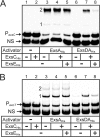ExsD inhibits expression of the Pseudomonas aeruginosa type III secretion system by disrupting ExsA self-association and DNA binding activity
- PMID: 20008065
- PMCID: PMC2832532
- DOI: 10.1128/JB.01457-09
ExsD inhibits expression of the Pseudomonas aeruginosa type III secretion system by disrupting ExsA self-association and DNA binding activity
Abstract
Pseudomonas aeruginosa utilizes a type III secretion system (T3SS) to damage eukaryotic host cells and evade phagocytosis. Transcription of the T3SS regulon is controlled by ExsA, a member of the AraC/XylS family of transcriptional regulators. ExsA-dependent transcription is coupled to type III secretory activity through a cascade of three interacting proteins (ExsC, ExsD, and ExsE). Genetic data suggest that ExsD functions as an antiactivator by preventing ExsA-dependent transcription, ExsC functions as an anti-antiactivator by binding to and inhibiting ExsD, and ExsE binds to and inhibits ExsC. T3SS gene expression is activated in response to low-calcium growth conditions or contact with host cells, both of which trigger secretion of ExsE. In the present study we reconstitute the T3SS regulatory cascade in vitro using purified components and find that the ExsD.ExsA complex lacks DNA binding activity. As predicted by the genetic data, ExsC addition dissociates the ExsD.ExsA complex through formation of an ExsD.ExsC complex, thereby releasing ExsA to bind T3SS promoters and activate transcription. Addition of ExsE to the purified system results in formation of the ExsE.ExsC complex and prevents ExsC from dissociating the ExsD.ExsA complex. Although purified ExsA is monomeric in solution, bacterial two-hybrid analyses demonstrate that ExsA can self-associate and that ExsD inhibits self-association of ExsA. Based on these data we propose a model in which ExsD regulates ExsA-dependent transcription by inhibiting the DNA-binding and self-association properties of ExsA.
Figures






References
-
- Brutinel, E. D., C. A. Vakulskas, K. M. Brady, and T. L. Yahr. 2008. Characterization of ExsA and of ExsA-dependent promoters required for expression of the Pseudomonas aeruginosa type III secretion system. Mol. Microbiol. 68:657-671. - PubMed
-
- Chai, Y., J. Zhu, and S. C. Winans. 2001. TrlR, a defective TraR-like protein of Agrobacterium tumefaciens, blocks TraR function in vitro by forming inactive TrlR:TraR dimers. Mol. Microbiol. 40:414-421. - PubMed
Publication types
MeSH terms
Substances
Grants and funding
LinkOut - more resources
Full Text Sources
Molecular Biology Databases
Research Materials

